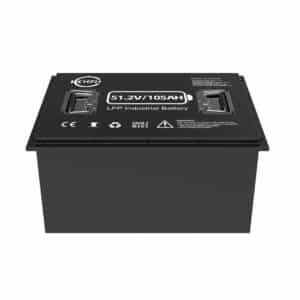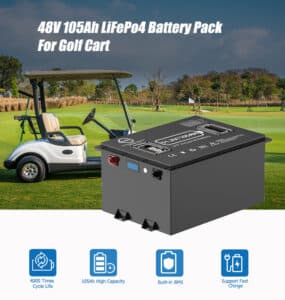Introduction to golf cart battery Count

As any golfer knows, a golf cart is more than just a means of transportation on the course; it’s an essential partner in enhancing the overall golf experience. Batteries are the centerpiece of every golf cart.
These unassuming but vital components provide the energy to propel a golf cart effortlessly through wide fairways and challenging terrain. With a reliable battery, golf carts could travel, disrupting the course of play and inconveniencing players and course maintenance staff.
The Importance of Golf Cart Batteries
There’s no denying that batteries are the lifeblood of any electric golf cart, serving as the power source that keeps the golf cart on the course. These rechargeable energy storage devices supply power to the golf cart’s motor for smooth acceleration and consistent performance. The reliance of golf carts on batteries highlights the integral role of batteries in the modern game of golf.
Types of Batteries Used in Golf Carts
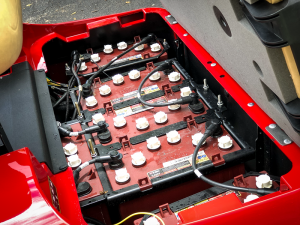
When it comes to powering golf carts, there are a variety of batteries to choose from, each with its characteristics and performance. Lead-acid batteries are a commonly used battery type known for their reliability and affordability.
Deep-cycle lead-acid batteries are prevalent because of their ability to withstand repeated recharging without loss of efficiency. Another type of battery is the flooded lead-acid battery, which requires regular maintenance but has a strong output.
Another type of battery is lithium-ion, which has a lighter design and longer life than traditional lead-acid batteries. Although initially more costly, lithium-ion batteries offer fast charging capabilities and higher energy density, making them an attractive option for those seeking cutting-edge technology for their golf carts.
Lithium-Ion Batteries
The Future of Golf Cart Power
Lithium-ion batteries are favored in the golf cart industry because they offer numerous advantages over traditional lead-acid batteries. One of the main advantages is the high energy density; lithium-ion batteries are smaller and lighter yet provide more power. This increased efficiency allows golf carts to travel longer distances without compromising performance.
Another outstanding feature is the longevity of lithium-ion batteries compared to lead-acid batteries. Lithium-ion technology can withstand more charge/discharge cycles before significant degradation occurs.
This extended life reduces replacement costs, lowering the total ownership cost for golf cart operators choosing a lithium-ion solution. In addition, lithium-ion batteries charge faster than lead-acid batteries, allowing for quick turnaround between uses without compromising the battery’s overall health.
The ability to charge efficiently is especially beneficial when continuous operation is required or when time is of the essence, and timely recharging is needed. As lithium-ion technology continues to advance, these benefits promise to become the power source of choice for modern golf carts.
Golf Cart Voltage Requirements
Golf carts typically utilize a 36V lithium battery or 48V lithium battery. The voltage requirements determine the performance and power output of the golf cart. 36-volt systems are usually used in older or smaller golf carts and can provide adequate power for transportation around the golf course.
On the other hand, 48-volt systems provide more power and efficiency, making them suitable for larger carts or carts used in more demanding environments. The choice of 36-volt or 48-volt depends on the intended use of the golf cart and the desired performance.
Series vs. Parallel Battery Configurations
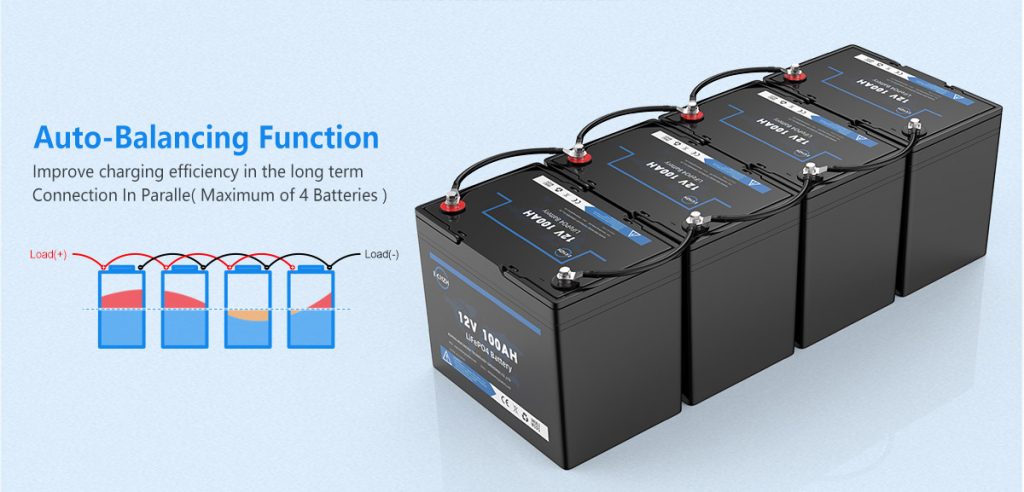
In a golf cart’s electrical system, batteries are connected in series or parallel configurations to achieve the desired voltage and capacity. Series connection involves connecting batteries end-to-end to increase the total voltage output while maintaining the same capacity.
On the other hand, parallel connection involves connecting batteries side-by-side to maintain voltage but increase total amp-hour capacity. The choice between series and parallel configurations depends on the balance between voltage requirements and battery capacity to ensure optimum performance and longevity of the overall system.
Determining the Number of Batteries Required Based on Voltage and Amp Hour Rating
The number of batteries required for a golf cart depends on the voltage required for operation and the number of amp-hour ratings needed for extended charging intervals. For example, a 36-volt system may require six 6-volt batteries connected in series to achieve the desired voltage output.
In contrast, a 48-volt system may require four series-connected 12-volt batteries to reach the operating voltage. In addition, selecting a battery with a higher amp-hour rating can increase the time between charges and run time, which affects the total number of batteries needed for optimal performance in a golf cart setup.
36V Golf Cart Battery Count
For 36-volt golf carts, the standard configuration usually includes a set of six 6-volt batteries. These batteries are connected in series to achieve the total voltage required for the golf cart to operate efficiently.
By connecting these batteries, they can collectively provide the power needed to drive the golf cart’s electric motor and other electrical components. 6-volt batteries are designed to withstand deep discharges, making them ideal for frequent charge/discharge cycles during everyday use on the golf course.
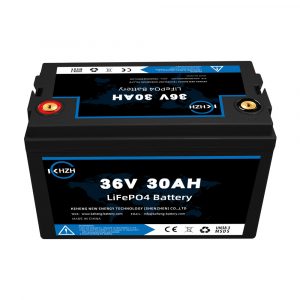
This 36V 30Ah lithium battery is made from Lithium Iron Phosphate (LiFePO 4 ), the safest and strongest lithium chemistry.
It provides 100% DOD (Depth of Discharge) – 5,000+ charge cycles and up to 7,000 charge cycles under ideal charging conditions.
The batteries contain a BMS that provides 1C continuous charging and discharging, plus they have a cold charge feature that allows for low-temperature charging starting at -20⁰C / -4⁰F. And it can run continuously in a partial state of charge (PSOC) without degrading performance. Provides excellent lifetime value.
48V Golf Cart battery Count
Unlike 36-volt systems, a typical 48-volt golf cart unit consists of four 12-volt batteries or six 8-volt batteries. Whether to use four higher-capacity batteries or six slightly lower-capacity batteries depends on factors such as space constraints in the battery compartment and desired performance characteristics.
As battery technology advances, many newer models move to higher voltage systems, such as 48 volts, to improve power output and efficiency. Manufacturers favor four 12-volt battery configurations for their simplicity and compatibility with standard automotive batteries.
Keheng’s 48V lithium batteries provide ample energy reserves for longer run times without compromising performance. They ensure a power-dense, lightweight, long-lasting lithium golf battery pack without compromising space dimensions, making them ideal for compact or lightweight golf cart designs.
Keheng’s 48v 200ah Lithium Golf Cart Battery provide ample energy reserves for longer run times without compromising performance, while ensuring a power-dense, lightweight, long-lasting lithium golf battery pack without compromising space dimensions, making them ideal for compact or lightweight golf cart designs.
Factors Affecting the Number of Batteries Used
In addition to voltage requirements, several vital factors affect determining the number of batteries in a golf cart setup. One of these critical factors is the capacity or amp-hour rating, which determines how long a battery can deliver current at its rated voltage before recharging. A higher-capacity battery can store more energy and support longer driving distances between charges, thus impacting performance and utility based on individual usage patterns.
In addition, factors such as physical space limitations within the battery compartment are essential in determining the number of batteries that can be accommodated. Some golf cart models may have limited space to accommodate additional or larger-sized batteries due to design constraints or space occupied by existing components in the chassis structure.
Manufacturers must carefully balance these space constraints with the desired performance characteristics when selecting the optimal battery configuration for a particular model. Another critical factor affecting battery count is the trade-off between cost-effectiveness and performance.
While increasing the number of batteries can improve overall power output and range, it can also increase the weight and complexity of the system, affecting handling and overall efficiency. When deciding how many batteries should be installed in a golf cart design, finding the optimal balance between cost-effective solutions that meet performance requirements is essential.
Golf Cart Battery Maintenance and Care Tips
Proper charging procedures are critical to maximizing the life and performance of lithium golf cart batteries. For lead-acid batteries, it is essential to use a charger designed for deep-cycle batteries.
Avoid overcharging or undercharging, as this can significantly reduce the efficiency and life of the battery. An intelligent charger with an automatic shut-off feature will prevent overcharging and ensure the battery remains in optimal condition.
Following the manufacturer’s recommendations for charging voltage and current limits is essential when charging your golf cart’s lithium-ion battery. Overheating is a common problem with lithium-ion batteries, so ensuring proper ventilation during the charging process is critical.
Additionally, rapid charging methods should be avoided as they can be detrimental to the battery’s overall health in the long run. By following these guidelines, golf cart owners can ensure that their batteries remain in top condition for the long term.
Extend Battery Life with Cleaning and Inspections
Regular cleaning and inspections are vital to extending the life of your golf cart battery. Dirt, debris, and corrosion buildup on the battery terminals can prevent proper electrical connections and decrease performance.
Gently cleaning the terminals with a mixture of baking soda and water helps to effectively remove corrosion without causing damage to the battery components. Inspecting the battery case for any signs of damage or leakage is also crucial to maintaining optimal performance.
Any cracks or leaks should be addressed immediately to prevent further deterioration of the battery structure. Additionally, regularly checking the water level in lead-acid batteries and refilling them with distilled water as needed will ensure that proper electrolyte levels are maintained for efficient operation.
Off-season storage recommendations
Proper storage during the off-season is critical to maintaining the health and capacity of your golf cart battery when not in use. Before storing your golf cart, fully charge the battery to prevent sulfation, which often occurs when lead-acid batteries are discharged for extended periods.
It is recommended that fully-charged lithium-ion batteries be stored at about 50% capacity in a cool, dry place out of direct sunlight. The battery should be checked periodically during storage to maintain it at the proper voltage level.
If storing lead-acid batteries, consider using a trickle charger or maintainer to keep the battery fully charged without overcharging. Implementing these storage recommendations will help maintain battery conditions during downtime so that they perform optimally when needed.
Conclusion
Proper battery maintenance is essential to ensure optimal performance and longevity of your golf cart. Routine maintenance tasks such as regularly checking the water level in lead-acid batteries, cleaning the terminals, and monitoring charging cycles can significantly extend the life of your batteries.
Careful maintenance of golf cart batteries ensures consistent performance and saves money by avoiding premature battery replacement. Remember, a well-maintained battery makes your drive on the golf course smoother and more enjoyable.
Taking care of your batteries and keeping up to date with the latest developments in the industry will ensure optimum performance and contribute to your golf cart’s sustainability. As we embark on the journey to provide greener, more efficient power for recreational vehicles, welcome these changes with optimism and enthusiasm.


